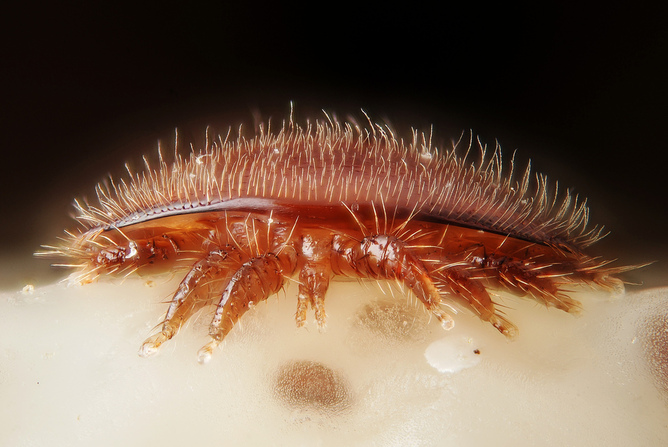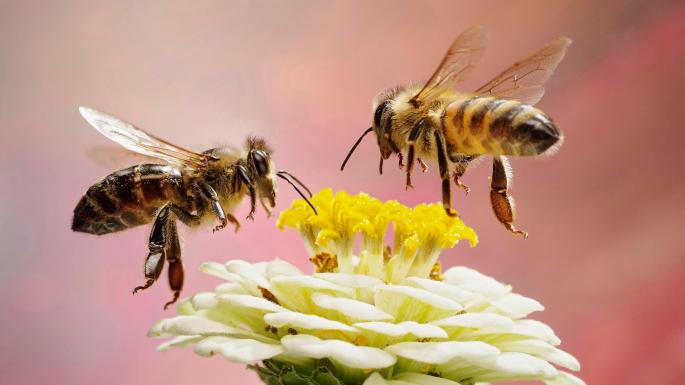
Dr John Roberts has a job that can cause him pain.
He works with honey bees (Apis mellifera). So naturally, this includes potentially dealing with angry bees when he comes into their space to research them.
We know about the positive contributions honey bees have on the environment. They play an important role in pollinating flowers, increasing plant sex diversity and maintaining our food security.
So how do we protect bees from getting sick? This is where John comes in. He's one of our researchers who looks at biosecurity threats to Australian honey bees – like Varroa mites and the bee viruses they spread.
What are Varroa mites?
Let's start at the beginning.
"Varroa mites are parasites that feed on developing and adult bees," John said.
There are two types of Varroa mite that are a problem: Varroa destructor and Varroa jacobsoni.
And how do they affect honey bees? Let's look at how the Varroa destructor mite affects adult bees as an example. The mite attaches to the bee's body and sucks on their 'fat body'. This is a part of the body that plays a huge role in energy production, growth and immunity.
As the mite feeds, the bee becomes severely weakened. In turn, their open wounds enable the spread of the deadly bee viruses that Varroa mites carry. There are many bee viruses that scientists have identified. The most serious is called deformed wing virus. As the name suggests, it can cause bees to have crumpled, deformed wings.
"The combination of Varroa mites and deformed wing virus is the biggest biological cause of bee colony deaths worldwide," John said.
The other thing with Varroa mites is they are very host-specific, meaning they can only survive on one host species. In this case, they only affect the European honey bee (Apis mellifera) or the Asian honey bee (Apis cerana).
Varroa mites originally only affected Asian honey bee populations. However, thanks to humans, they have spread to European honey bee populations around the world. Large infestations of Varroa destructor mites have occurred in Europe, North America and New Zealand.
Fortunately, Australia's honey bees are the largest population left that aren't affected by these mites or deformed wing virus. But there is a very real potential for arrival and spread in Australia.
"And deformed wing virus can infect other insects. It also presents a risk to our native pollinators by 'spilling-over’ from infected honey bees," John said.

John Roberts is a Guardian of the Apiary
Honey bees pollinate about a third of Australia's food crops - that's one in every three mouthfuls! A 2017 report estimated they contribute about $6 billion a year to the Australian economy.
So it's safe to say that keeping Australia's honey bees and native pollinators healthy is important for the wider community.
Enter John.
"My research is aimed at improving bee health and securing pollination services in Australia. I also research Varroa mites and their viruses to inform Australia's biosecurity practices and improve our preparedness for these threats," John said.
"I’m currently leading a project looking to import into Australia honey bee genetics with tolerance to Varroa mites, but without bringing in exotic viruses like deformed wing virus."
John and his team are currently laying the groundwork to make it easier and safer to import these honey bees. The aim is to screen the honey bee's germplasm - this is the tissue containing the animal's DNA. But researchers want it from bees not infected by unwanted viruses.
Preferred honey bee colonies can be screened before entering the country and after to make sure they haven't brought in any viruses.
Introducing this protective DNA into our honey bee population can help beekeepers breed tolerant bees before Varroa mites get here. Keeping this protective DNA in the bee population is a challenge without Varroa mites - if you don't use it, you lose it. However, we can use genetic tests to track the protective DNA and make sure it gets inherited by the next generation of honey bees.
Protecting honey bees in Papua New Guinea
John is also researching an emerging Varroa mite species in Papua New Guinea. It's different to the Varroa destructor mite affecting global bee populations," he said.
"My research has found the Varroa jacobsoni mite has more recently jumped from the Asian honey bee. And the Papua New Guinea honey bees have become tolerant to these mites. We think this is because they do not have deformed wing virus," he said.
John and his team haven't figured out how the Papua New Guinea honey bees are protected. It is likely that Varroa jacobsoni mites don't inflict as much damage when they aren't spreading viruses. But the honey bees may have also developed behaviours which protect them better from attacking mites.
But ultimately, these bees don't get and become sick with deformed wing virus. And that's good news for our Australian honey bees.
"My research has also found deformed wing virus is not in the Australian honey bee population. This could significantly reduce the impact of a future Varroa mite invasion," John said.
"As we saw with the Papua New Guinea honey bees, mite feeding alone is not as harmful as mite feeding combined with a virus."
Life in the lab
When researching honey bees, you can find John inside the lab and outside with the bee hives.
"Much of my research involves analysing the DNA or RNA of bees and their pathogens, or organisms which cause disease. So I spend plenty of time in the molecular lab," he said.
"I use a lot of quantitative polymerase chain reaction (qPCR) to diagnose pathogens. I also use high-throughput sequencing to discover new bee viruses and detect plant pathogens they have encountered while foraging.
"But I also need to get the samples to analyse those DNA or RNA sequences in the first place. That means I get to run field experiments and collect hive samples, which includes the occasional bee sting. My low-tech equipment is just as important. It includes a smoker and hive tool for opening up bee hives," he said.
Bee-hold the future
John's time with us has always centred around bees. He joined us as a post-doctoral research fellow in 2010 to research the genetics and viruses of Varroa jacobsoni in Papua New Guinea.
And the bee research continues! John's research will help stop our honey bees from falling victim to this destructive parasite.
"We'll look at the genomics of Varroa tolerant honey bees to uncover the molecular mechanisms of this behaviour. We’ll also develop genetic tools to assist breeding programs in Australia," he said.
